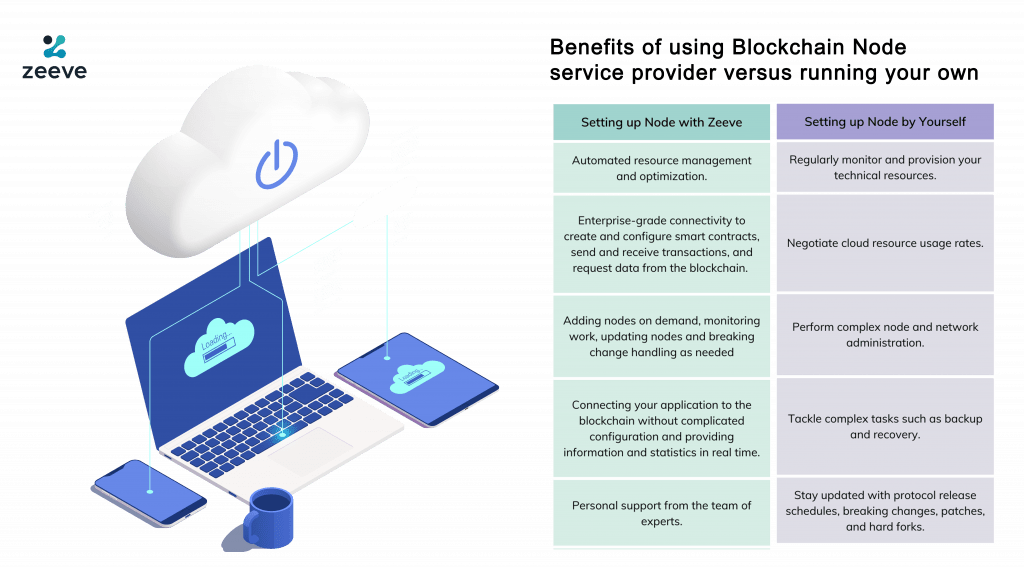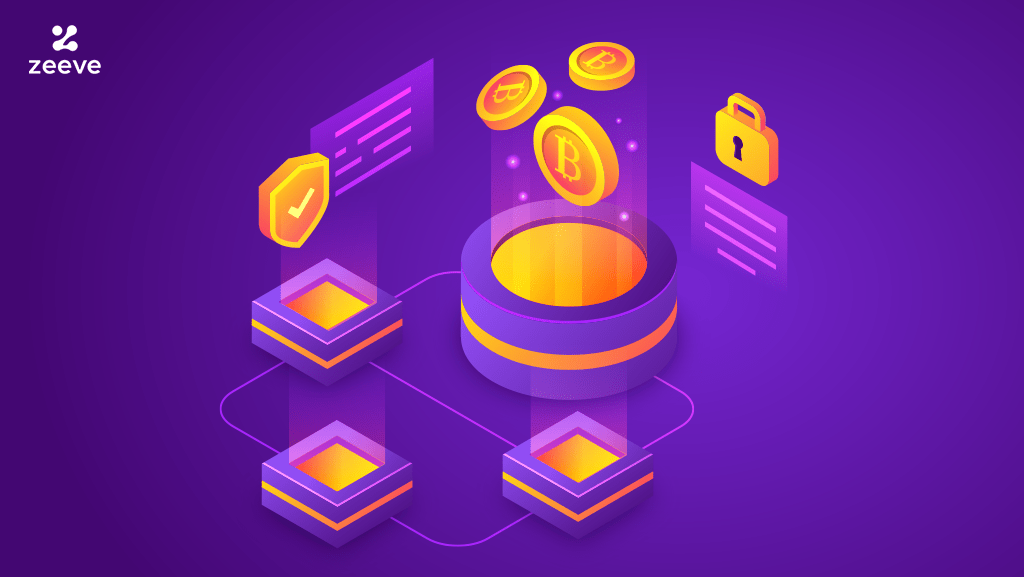Blockchain technology has been gaining immense popularity and more and more industries are moving towards it realizing the numerous benefits it carries. With the help of revolutionary blockchain technology, organizations can engage in secure and highly transparent transactions and also increase their efficiency and overall productivity. The technology also helps companies to enhance their capabilities to set up safe networks and participate in real-time communications with partners around the world.
Peer-to-Peer (P2P) topology is a characteristic associated with blockchain technology, a distributed ledger technology (DLT). This technology enables users to store data across thousands of servers, allowing any user to have a clear view of the data at any time thanks to its decentralized nature and easy accessibility to the database. Hence, there is no single, central entity.
As a platform for virtual currencies, Blockchain has the potential to support the programmable economy. Blockchain-based digital monies are already having a massive influence and central banks are working with them, but its significance goes beyond trade interaction. For a complete understanding of this ground-breaking technology, we also need to understand the vital components that make it such a force to reckon with. An essential component that requires a deep understanding when touching upon the implementation of blockchain in the workflow is the understanding of blockchain nodes and also the relevance of deploying them by expert node automation platform.
In this blog, we would take a sneak peek into blockchain nodes- the most essential component of the decentralized ledger and also why there is a need for node service providers.
Nodes and Blockchains
The increased interest in bitcoin is boosting people’s desire to understand how blockchain- the technology behind it operates. It is important to understand the basic principles behind it and getting an insight into how nodes work and are set up is significant. Nodes are the many components of the blockchain network that enable cryptocurrency, and nodes communicate with one another to track transactions and new blocks.
The node is an integral part of the blockchain network- a decentralized open-source ledger for cryptocurrency transactions. Blockchain nodes hold a copy of the blockchain data and are responsible for the stored data. Nodes are utilized by developers for the creation of blockchain-based applications. Most prominent cryptocurrencies, like Bitcoin and Dogecoin, require a node to function.
Function and role of blockchain node
A blockchain node is a cross-platform, open-source runtime that allows developers to build a variety of services. The Peer-To-Peer protocol permits nodes to connect to third parties, share information about transactions, and create new blocks within the blockchain.
A “blockchain node” is usually associated with blockchain, a decentralized digital ledger that records all bitcoin transactions and makes the information available to anyone with an internet connection. This implies that every transaction on the blockchain is recorded chronologically and transmitted to a network of connected devices. These devices are referred to as nodes. Nodes interact with each other in the network and exchange data about transactions and new blocks.
Nodes constitute an integral part of the blockchain’s design, ensuring its security and integrity. Primarily, a node is tasked with verifying each block of network transactions. Each node has a unique identification that differentiates it from the others.
The responsibility for the trustworthiness and accuracy of entered data in the distributed ledger falls on the nodes in the network. A complete record of distributed entry can be stored on each node in the network. It is solely for these blockchain nodes that users can easily access the data and scrutinize all transactions done or recorded on the network. Nodes engage in consensus, communicate, and fund transactions, confirm and record confirmations, and take part in the setting up of new blocks in the blockchain, for which they are awarded.
Launching a network node is an important way to contribute towards the decentralization and speed of our blockchain. By setting up your own nodes, you can receive small incomes from transactions that go through them! Getting commissions for transfers, and the purchase/sale of cryptocurrency assets on the exchange is the foundation of a node-based business. Hence, it is crucial to gain some knowledge about the deployment of node and its significance for
The process of setting up and running nodes is extremely difficult and time-consuming, which proved to be a disadvantage for start-ups and hence they turn to the node hosting, deploying platforms. Blockchain businesses have begun consulting specialized service providers to set up nodes on their blockchains and to focus on other prominent areas of growth.
How to deploy a node?
Software, hardware and network connections must all be configured properly when installing a full blockchain node. There are certain requirements that a developer must execute when deploying a full node. It is necessary to take into account the memory and processing capacity when deploying a node as getting them launched on weak equipment is no longer a possibility with blockchains becoming immensely popular and requiring more power.
Check out our guides to deploy Hyperledger Fabric, Bitcoin, Polygon, Ethereum, and Fluree nodes.
Get an insight into the minimum hardware requirements prior to deployment of a node as there may be varying requirements for node hosting. For example, the requirements for installing a node for the existing crypto coins differ significantly. Here is a list of the minimum set standards for the deployment of a Bitcoin node:
· Check your device for the updated version of Windows, Mac OS X, or Linux.
· A minimum of 500 GB available with a minimum data transfer speed of 100 MB per s.
· A solid state drive (SSD) capable of performing 68 MB per second random write and 30.9 MB per second random read.
· At least 112GB of memory space.
· High storage space, memory and also high-speed internet connection is required.
· The Internet connection must be unlimited with a high upload speed.
You can synchronize an Ethereum node in the following three modes: fast, full, and light. The fast node is the default mode used. In this mode, there are neither downloads of transaction history, wallet balances, smart contract codes.
Full mode requires powerful hardware, lots of RAM, and an easy-access SSD disk. Archiving of the Ethereum node can be a lengthy process, requiring several weeks or months to be completed even on a single storage drive. In case of an error in the customer program version, it is advisable to start from a clean slate. Cyber Security will also be a substantial investment. You also have to be careful to make sure that your site is safe and sound from unauthorized access.
If you synchronize nodes from the HDD (hard disk), the node may not be able to synchronize because of the importance of the speed of blockchain creation (most frequently, it’s greater than normal) and that of writing to disk. The speed of network connection and the capabilities of the equipment involved also come into play.
The Ethereum light node synchronization mode was cited as being one of the most challenging by users. Errors are mostly registered in this mode, yet its balanced speed is no exception, and it uses the least amount of resources, there is room for wallet balances, and smart contract functions are pulled up.
You can connect a node to the main network or run it on a temporary network connection for any of your functions testing, development.
A standard Ethereum node runs as a background function by default. Instead of running as a function on the operating system or creating a node on the display, the function is executed by writing directly on the system or starting a virtual node. You should carefully consider where exactly the default node runs. If the node is run by test, then you won’t be able to monitor transactions.
To make a Bitcoin node that supports the blockchain, you need to create a Bitcoin folder and then save it in your file system. To log the whole bitcoin blockchain, powerful hard disk space is required.
The downloading process can be quite time consuming. In addition, hardware issues can also be detected, and a failed download will automatically begin from the point at which it was interrupted. Next, the client will begin the blockchain-copying procedure after it was completed successfully. Then, to bring the node up, you need to permit the incoming connection through port 8333 in your firewall. Also, you will need to check whether the node is working. For this, indicate any information related to the item, or request data from the blockchain.
The next step is to assess if the node is working. To accomplish this, send a request to the node with any information about the product, or request data from the blockchain.
To ensure the node is accurately monitoring the TCP port, make sure that you have a standard check available for this port. As long as the error occurs, you must restart the node manually.
Problems you may face when deploying a node yourself:
Limited bandwidth: Some internet plans will charge extra for accessing additional bandwidth not included in the scheduled plan. Make sure your plan doesn’t contain network traffic limitations before activating it. Additionally, your internet connection could be unstable. If the synchronization with the blockchain network is interrupted while transmitting cryptocurrency, you’ll need a reboot.
Site deployment can slow down or bottleneck your network’s regular traffic.
Hackers can discover that a new full node is operational and try to exploit it. You are completely responsible for protecting your node from malicious hacking.
Hence summing up, deploying a full node will cost money for creating equipment in compliance with such requirements, ensuring uninterrupted online connection, and enabling you to utilize the command line.
Tips needed to tackle when deploying a node yourself:
Node deployment can be a daunting task, but with the right planning and preparation, it can be a manageable process.
Plan for reliability and availability: When deploying a node, check if that is well maintained and also network configured to deliver best performance. Also check for adequate disk space and the memory to ensure that the blockchain application can function smoothly.
Acquire technical knowhow: Deploying the node requires some technical knowledge to understand the varying requirements and also the various steps involved in successful deployment of a node.

How does a blockchain service provider work?
It is possible to install the node on your own but often the lack of technical experience and complexities involved in node deployment can considerably heighten the challenge. Moreover, it can be time-consuming and effort-intensive so it is best to look for a reliable and experienced blockchain-as-a-service company that performs all the important tasks and activities to maintain and manage the blockchain infrastructure.
The node provider installs the core resources needed, develops the associated infrastructure and deploys nodes directly connected to the blockchain.
Node providers may facilitate access to networks pertaining to popular cryptocurrencies, such as Bitcoin, Ethereum, Monero, Litecoin, R3 Corda, Polygon, Axia, and others, depending on your requirements. The supplier takes on complete responsibility for all aspects of the node. For the client, a blockchain node provider is a convenient method of gaining and losing access to your node at any time.
You can set up blockchain node service providers to focus on your overall company and strategies without needing to manage the complex distributed ledger network and its services.
It is generally more costly to install a personal blockchain than a cloud-hosted one. On-premises blockchain, irrespective of the individual, can be quite expensive and most of the costs might arise because of the initial costs such as personnel, infrastructure, hardware, software, licensing, consulting, etc., operating costs (e.g., management, monitoring, etc.), and decommissioning (archiving, decommissioning server racks, etc.). The initial price of these services can be quite high, owing to the high cost of the resources that are used.
When estimating the costs of using cloud solutions also take into account the factors such as the number of requests to the node sent at a certain time, node stability, timely updates and security.
Criteria for choosing Blockchain Node Deployment Company
When selecting a cloud service provider, it is essential to consider some other parameters such as their experience and backend services.
Services and support: Be sure that the blockchain-enabled systems, backend services and solutions that the company uses are user-friendly and can be applied to your product.
Pricing model: Take into account the pricing of node deployment, monitoring and also factor in the terms of service support, and post-deployment support for dedicated nodes.
Review the security: Examine the level of security to find minor flaws. Blockchain systems call for considerable expertise and an inspection of a similar category’s holdings can tell you a lot about blockchain infrastructure.
Prior experience in blockchain infrastructure: Focus on the track record of your chosen node deployment service provider of developing and deploying blockchain technologies in a niche similar to your own in order to maximize your proficiency in blockchain infrastructure.
Partner with Zeeve for node deployment
Zeeve is one of the leading blockchain as a service (BaaS) platforms that supports businesses and blockchain-based start-ups to create, deploy, and manage decentralized applications and blockchain networks. It is a low-code automation platform that supports the backends of several blockchain protocols and provides comprehensive analytics. It not only deploys and builds the blockchain networks but also supervises their nodes.
Zeeve provides Enterprise Blockchain Management Platform capabilities to DevOps teams deploying and managing Blockchain nodes and networks. We’re an enterprise Blockchain Management Platform that can manage the Blockchain network efficiently and with ease. Our company will use our platform for your own network.
We will manage the nodes for you and save you from the hassle of node deployment, sharing and tracking them. Don’t hesitate to get in touch with our team to learn about our blockchain sharing, managing, and deploying infrastructure platform.




